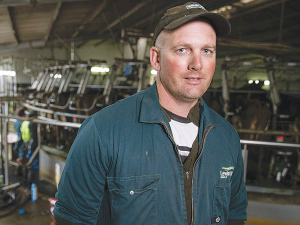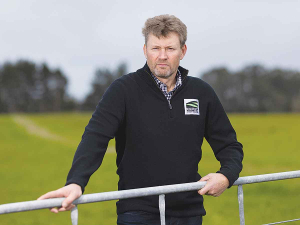While it's always good to hear positive news stories, the latest Situation and Outlook report for dairy may be a tad rosy, says Feds national dairy spokesman Chris Lewis.
The Outlook report is forecasting that dairy exports will be up 5.5% to June 2019 but Lewis says the dry weather may pull that back a little.
“We need to heed caution because a lot of [regions] in the last couple of months have been very dry,” says Lewis. “We haven’t finished the season yet, so while it will still be a positive story, at the end production may not be as high as predicted.
“So the 5% (the report says production was up 5.6% at end of January) could come back a little bit. But we are getting paid a bit more than last year so that is positive.
“As farmers we look forward to more of these positive stories and how we help contribute to the country’s growth and GDP. But we are very much a pasture based country and we have been dry the last few months, the grass stops growing, we produce less milk and that’s just what happens.
“It is still going to be a positive story but not as positive as that 5%. But I see the milk price is increasing so it all balances out.”
DairyNZ chief executive Dr Tim Mackle says the dairy sector is thrilled to see that its significant contribution to the New Zealand economy is affirmed in the latest Situation and Outlook for Primary Industries 2019 report.
“It is great to see this acknowledgement of the huge part the dairy sector plays in the economy,” he says.
The Ministry for Primary Industries March 2019 report says dairy export revenue is forecast to rise 5.5% to $17.6 billion for the year ending June 2019, up from 13.3b in 2016, $14.6b in 2017 and $16.7b in 2018.
Increased milksolids production translated into higher export volumes, and a reversal of declines in key dairy commodity prices at the end of 2018 continued into 2019.
Total dairy exports for the six months ended December 2018 grew 3.8% to $8.7b vs the previous year. Strong international demand continues for dairy, including from China. Dairy exports to China, as our largest trading partner, are up 16.6% to $3.2b for the six months ended December 2018 vs the previous year.
“For NZ’s dairy farmers, the strong production, a recovery of export commodity prices and a weaker NZD should help ease downward pressure on farm level profitability for the current season. We have accordingly adjusted our all-company average farmgate milksolids payout forecast for the 2018-19 season upwards to $6.41/kgMS (including dividend),” the MPI report says.
Mackle says the dairy sector contributes to national and regional economic development, supports NZ’s wellbeing and employs 46,000 workers nationwide. The latest dairy achievements align with the dairy sector’s strategy, Dairy Tomorrow, which aspires to improve the lives of NZers with every drop of milk, Mackle says.
“The continuing success of the dairy sector shows that farmers are working hard to provide a better standard of living for all Kiwis, while running profitable businesses and looking after their animals, people and the environment.
“To continue to achieve stellar results like this and to farm well, we need to have sufficient skilled and passionate people in the dairy sector.
“At present, we have skills shortages and need more people with the necessary skills and education to help us continue to drive the sector forward and deliver benefits for NZrs and the economy.”
Reforms must benefit industry
DairyNZ is contributing to a wide-ranging reform of the vocational education system proposed by Education Minister Chris Hipkins.
Tim Mackle says: “We will ensure the dairy sector voice is heard, as we need a system that is responsive to dairy’s needs. We want to ensure that education — on and off the job — is delivered in a way that supports farmers and their staff to get the skills they need to run effective and efficient businesses and to have rewarding careers”.
The dairy sector needs about 5000 new people each year. The sector must have access to migrant employees because there are not enough New Zealanders to fill vacancies, Mackle said.
“Migrant employees are valued members of our farm teams. We want to work with the Government to ensure that businesses can plan knowing they have certainty of labour supply.”











